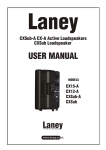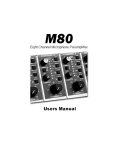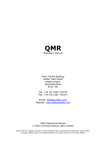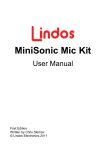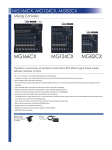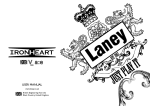Download MP20 Owner`s Manual
Transcript
MP20 T W O C H A N N E L M I C R O P H O N E P R E - A M P L I F I E R USERS MANUAL Version 1.1 ? 1999,2001, PreSonus Audio Electronics, Incorporated. All rights reserved. W A R R A N T Y PreSonus Limited Warranty PreSonus Audio Electronics Inc. warrants this product to be free of defects in material and workmanship for a period of one year from the date of original retail purchase. This warranty is enforceable only by the original retail purchaser. To be protected by this warranty, the purchaser must complete and return the enclosed warranty card within 14 days of purchase. During the warranty period PreSonus shall, at its sole and absolute option, repair or replace, free of charge, any product that proves to be defective on inspection by PreSonus or its authorized service representative. To obtain warranty service, the purchaser must first call or write PreSonus at the address and telephone number printed below to obtain a Return Authorization Number and instructions of where to return the unit for service. All inquiries must be accompanied by a description of the problem. All authorized returns must be sent to the PreSonus repair facility postage prepaid, insured and properly packaged. PreSonus reserves the right to update any unit returned for repair. PreSonus reserves the right to change or improve the design of the product at any time without prior notice. This warranty does not cover claims for damage due to abuse, neglect, alteration or attempted repair by unauthorized personnel, and is limited to failures arising during normal use that are due to defects in material or workmanship in the product. Any implied warranties, including implied warranties of merchantability and fitness for a particular purpose, are limited in duration to the length of this limited warranty. Some states do not allow limitations on how long an implied warranty lasts, so the above limitation may not apply to you. In no event will PreSonus be liable for incidental, consequential or other damages resulting from the breach of any express or implied warranty, including, among other things, damage to property, damage based on inconvenience or on loss of use of the product, and, to the extent permitted by law, damages for personal injury. Some states do not allow the exclusion of limitation of incidental or consequential damages, so the above limitation or exclusion may not apply to you. This warranty gives you specific legal rights, and you may also have other rights, which vary form state to state. This warranty only applies to products sold and used in the United States of America. For warranty information in all other countries please refer to your local distributor. PreSonus Audio Electronics, Inc. 7257 Florida Blvd. Baton Rouge, LA 70806 (225) 216-7887 [email protected] ? 2001, PreSonus Audio Electronics, Incorporated. All rights reserved. TABLE OF CONT ENTS 1 Overview 1.1 Introduction 4 1.2 Features 4 2 Controls & Connections 2.1 Front Panel Basic Layout 8 2.2 Preamplifier Section 9 2.3 Master Channel 11 2.4 Back Panel Basic Layout 11 2.5 Power Supply 13 3 Operation 3.1 Dynamic Microphones 14 3.2 Phantom Powered Microphones 14 3.3 Instrument Input 14 3.4 Inserting Compressors, EQ’s, etc. 14 3.5 Using Return as Line In 15 3.6 Aux Input – Cascading Mixes 15 4 4.1 Technical Specifications 16 3 1 OVERVIEW 1.1 INTRODUCTION Thank you for purchasing the PreSonus MP20 Two Channel Microphone / Instrument Preamplifier with Stereo Bus. This pre-amp was designed using state of the art components to deliver crystal clear audio for an infinite period of time. We believe the MP20 to be an exceptional sounding unit and an exceptional value. Feel free to contact us at 1-800-750-0323 anytime for any reason whatsoever. We value your suggestions and your comments. PreSonus Audio Electronics is committed to constant product improvement and feel the best way to accomplish this task is by listening to the experts on our gear, our valued customers. We appreciate the support you have shown us through the purchase of our products. Please pay close attention to how you connect your MP20 to your system. Improper grounding is the most common cause of noise problems found in studio or live sound systems. We urge you to scan this manual before hooking up your MP20 to become familiar with its features and various applications. Good luck and enjoy your MP20! 4 OVERVIEW 1.2 FEATURES The following is a summary of your MP20’s features: ? FET, Class A Discrete Input Buffers. Each channel of your MP20 contains a Class A discrete input buffer followed by a dual servo gain stage. This provides ultra low noise and wide gain control. This allows the MP20 user to boost desirable signal without increasing unwanted background noise (NO capacitors!) ? 48 Volt Phantom Power. Each channel of the MP20 has 48V Phantom power available. When the Phantom power switch is engaged, power is supplied at a constant rate whether one or both channels are utilized. This assures optimum performance of your condenser microphone(s) and that it will be free of distortion associated with insufficient power. ? Polarity Reverse. A phase reverse switch is provided on each channel. This switch enables the user to invert the phase of a microphone when phase cancellation is noted. The phase reverse switch allows the operator to avoid phase cancellation when identical microphones are used in close proximity to one another. The phase reverse switch also can compensate for different XLR connector hook-ups where pin connections have been inverted. ? 20 dB Pad. A 20 dB pad is available on each channel for reducing the in-coming signal level. This pad provides a more manageable signal from high output devices giving the operator greater control over the in-coming signal and a much reduced chance of over-driving the input and thereby avoiding distortion. ? +28 dB Headroom. The MP20 has +28 dBu of 5 OVERVIEW headroom on each channel. This feature gives you a very wide dynamic range and excellent transient response characteristics. ? Rumble Filter. A Rumble filter is provided on each channel for eliminating low frequency noise. This lets you greatly reduce background noise such as air conditioners or wind noise with the flick of a switch without effecting the desired frequencies. ? Microphone or Instrument Input. Each channel of the MP20 has a separate XLR microphone input on the rear of the unit and a female 1/4”instrument input jack located on the front panel. ? High Quality Transformer with IDSS Control. The MP20 offers a high quality transformer on each channel. These feature an IDSS control (this control adjusts the drain current on the input FET amplifier altering the even harmonic levels of the signal being passed) with an adjustment range of 0% to 100%. The 0% position passes a pure signal. As the control is rotated to the 100% position, the signal’s even harmonic series is boosted giving the signal “warmth” very much like a vacuum tube or similar to the sound of analog tape saturation. This remarkable effect gives you the sound of a tube without the headache of uneven performance often encountered with vacuum tube devices ( no tube to pickup RF or to age and become “microphonic”) ? Mix Bus. The MP20 has a stereo summing bus for combining the input signals assigned to the bus using the L/R function switch on the front panel of the MP20. A pan knob allows the placement of the selected signal anywhere in the stereo array of the stereo summing bus out-going signal (i.e.- left; left-center; center; right-center or 6 OVERVIEW right). ? High Gain Headphone Jack. Inserting stereo headphones into the jack on the front panel of the MP20 enables the user to monitor the signals assigned to the Stereo bus. Ample power has been provided to allow the operator to hear the processed signals in loud ambient noise environments such as concert halls or clubs or in control rooms monitoring at high volume levels. 7 2 CONTROLS & CONNECT IONS 2.1 FRONT PANEL BASIC LAYOUT Notice that the front panel is divided into two identical Preamplifier sections Channel One and Channel Two - plus a Master section. Channel One and Channel Two are the two microphone preamplifier channels of the MP20. Both preamp channels contain: ? 80 Hz Filter ? L/R Assign ? Phantom Power Switch ? Phase Reverse Switch ? -20db Pad ? IDSS Control ? Gain Control ? Pan 8 CONTROLS & CONNECTIO NS Master Channel contains: ? Stereo Output Control ? Headphone Level Control 2.2 PREAMPLIFIER SECTION L/R Assign button assigns the signal coming through the channel to the Stereo Summing Bus output. Pan control provides constant power panning to the Stereo Summing Bus. IDSS Control selects the amount of boost (0% to 100%) applied to the even harmonic series of the signal being amplified by a channel of the MP20. The effect of manipulating the harmonic distortion is of increasing or decreasing the apparent “warmth”of the signal. This capability is derived from the transformer and its dual servo gain stage. This proprietary feature of PreSonus products was introduced in the PreSonus M80 Eight Channel Microphone Pre-Amplifier. Experiment with the IDSS control and see what type of sounds you can get from your present microphone selection. Phantom Power is available to each channel input of the MP20. The 48 volts is supplied by way of the XLR connector for condenser mics and any 9 CONTROLS & CONNECTIO NS other devices requiring continuous power through the XLR input. This power is supplied at a constant level allowing use of both inputs simultaneously for condenser mics without any degradation of audio quality. PIN 1 GND PIN 2 +48v PIN 3 +48v XLR connector wiring for Phantom Power Phase Reverse Switch allows the user to invert the polarity of the XLR connector by switching pins two and three. The inversion of the pins of the XLR connector may be necessary to alter the audio phase of two like microphones to compensate for phase cancellation. It may be required that the wiring of a cable’s XLR connector be switched to successfully utilize Phantom power. -20 dB Pad provides -20 decibels of attenuation with the push of a button. This is a very useful feature for rapidly reducing the level coming into the MP20 and thus preventing the input signal from over-modulating (distorting) the input. This may occur due to high output level from a microphone or line device. Padding the input serves to provide increased “headroom”for the operator. 80 Hz Filter. The MP20 has an eighty-hertz filter that is activated by engaging the switch on the front panel. This filter (often referred to as a RUMBLE filter) is useful for eliminating extraneous low-end information from the signal being amplified. Frequencies from eighty hertz and below are cut from the incoming signal. This feature is useful in eliminating low frequency noise such as air-conditioning rumble or for reducing the sound of footsteps or other types of vibrations from being transmitted through the microphone stand into the microphone. Gain. This control provides 60dB of gain. The amplifier has inherent gain of 10 CONTROLS & CONNECTIO NS 12dB thus delivering a total gain possibility of 72dB. INSTRUMENT. This 1/4 inch input is provided so the MP20 can be used to boost low level instrument signals such as those typically encountered with electric bass and guitar. This feature is commonly referred to as a DI. This input allows pick-ups of electric and acoustic instruments to resonate at full frequency. Care must be observed when using this input to accept signals from instrument pre-amplifiers to avoid distortion. 2.3 MASTER CHANNEL LEVEL. This control adjusts the output level of the Stereo Summing Bus. Channels are assigned to the bus via the L/R assign switch on each of the two pre-amp channels of the MP20. PHONES. A headphone volume control (Phones) is located to the left of the 1/4-inch stereo headphone output jack on the front panel. The signal monitored by the headphones is the same signal provided by the Stereo Summing Bus to the Mix Output XLR’s on the rear panel of the MP20. POWER. A lighted push button is located on the front panel for turning the MP20 On and Off. 11 CONTROLS & CONNECTIO NS 2.4 BACK PANEL BASIC LAYOUT PIN 1 GND PIN 2 High (+) PIN 3 Low (-) Cable Wiring Diagram for Input and Output XLR The Output XLR Connector is servo balanced and operates at +4dBu. The Return / Line In connector of the MP20 is provided for use in conjunction with audio process devices such as compressor/limiters and as a Line In for recording media such as tape machines, hard disc recorders, or DAT’s. When a device is connected to this jack, the Neutrik? Combo jack is disconnected. TIP High (+) RING Low (-) SLEEVE GND Cable Wiring Diagram for Balanced Send / Return Jacks The Send Jack on the back panel of the MP20 routes the signal being processed by the channel to outboard devices or to recording media. 12 CONTROLS & CONNECTIO NS MIX OUTPUT. A pair of XLR connectors is provided for the Left and Right Outputs of the stereo summing bus. Signals are assigned to these outputs using the L/R Assign switches on the individual channels. 2.7 POWER SUPPLY The Power Jack on your MP20 accepts a standard IEC cord like those found on most computers and professional recorders. Your MP20 has been designed to operate at the proper voltage for the country where you purchased your unit. Make sure that the power requirement of your unit matches the voltage of the country where the unit will be used. (USA = 115V) 13 3 OPERATION 3.1 DYNAMIC MICROPHONES Dynamic microphones are characterized by lower output levels. Hence, more gain is needed to amplify a dynamic microphone to operating level. Occasionally it is necessary to add the –20dB pad to the microphone to avoid distortion (e.g. when recording percussion). Do not use phantom power when using dynamic microphones. 3.2 PHANTOM POWERED MICROPHONES Phantom powered microphones such as condenser and some ribbon microphones require external power to pre-amplify the microphone acoustic pickup. These microphones typically have much higher output than dynamic microphones. Hence the –20dB pad is almost always necessary when close micing to avoid clipping the amplifier. 3.3 INSTRUMENT INPUT The instrument input is designed to handle ¼”plugs from instruments such as guitars and basses. This instrument input is an ultra high impedance amplifier designed to allow the full audio potential of an acoustic or electric instrument pickup to be realized. Care should be taken not to overdrive the input with instrument preamplifiers. 3 . 4 I N S E R T I N G C O M P R E S S O R S , E Q ’S , E T C . Each channel of the MP20 features a send jack and a return jack. This feature allows the use of external processors such as compression and equalization devices. Simply connect the send jack, balanced or unbalanced to the input of the external processor. Then connect the MP20’s return jack to the output of the external processor. The signal is now routed out of the MP20, into the external processor, then back into the MP20. The final, processed signal will be available at the MP20 channel output XLR connector or the Mix Bus output if assigned to the mix bus. 14 OPERATION 3.5 USING RETURN AS LINE IN The return jacks on each channel can be used to insert external audio devices such as tape machine outputs, DAT machine outputs, etc. This then makes the audio device available to the mix bus for mixing in with microphones or instruments. 15 4 TECHNICAL MP20 Technical Specifications: Number of Channels Dynamic Range Noise Floor @ Bus Noise Floor @ Main Output Noise Floor @ Channel Output, +24dB Gain Headroom Frequency Response +/- 0.5dB Crosstalk Channel Gain, Microphone Input THD + Noise, (no idss) THD + Noise, (max idss) +24dB to +60dB 0.0024% 0.035% Input Impedance, Mic Input Input Impedance, Instrument Input Output Impedance THD + Noise Bus Master Output Control Metering Send Output Impedance Return Input Impedance Internal Operation Level Input Connectors Output Connectors Send Connector Return Connector Two >120dB -90.2dBu -88.4dBu -94.2dBu +28dBu 10Hz to 60kHz >82dB @ 10kHz 1.3k Ohms 1Meg Ohms 51 Ohms <0.02% -72dBu to +10dBu Full scale 51 Ohms 10k Ohms +4dBu = 0dB XLR & 1/4”, Tip Sleeve XLR 1/4”, Tip Ring Sleeve 1/4”, Tip Ring Sleeve Power Supply Internal, Toroidal Transformer, Linear Supply 100VAC to 120VAC, or 200VAC to 240VAC EIC receptacle 1U Rack 19” X 1.75” X 7” 7 lbs. Power Requirements Main Connection Size Weight As a commitment to constant improvement, PreSonus, Inc. reserves the right to change any specification stated herein at any time in the future without notification. 16 OPERATION 17

















